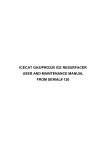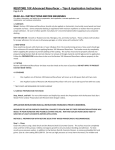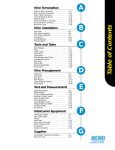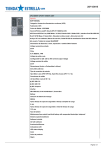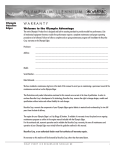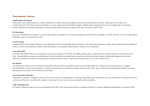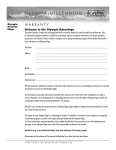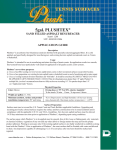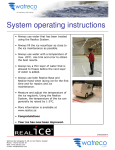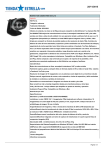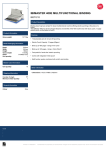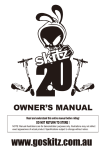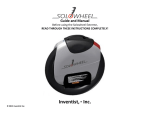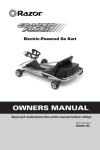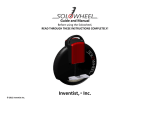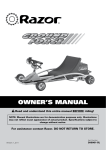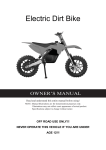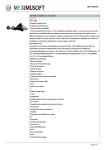Download icecat pro220 ice resurfacer user and maintenance manual
Transcript
ICECAT PRO220 ICE RESURFACER USER AND MAINTENANCE MANUAL TABLE OF CONTENTS 1. USER MANUAL ............................................................................................4 1.1. Introduction .................................................................................................................. 4 1.2. Safety Instructions ....................................................................................................... 4 1.3. Machine Dimensions ................................................................................................... 5 1.4. Main Parts of the Machine........................................................................................... 6 1.4.1. Controls ................................................................................................................ 7 1.4.2. Driving Controls .................................................................................................. 8 1.4.3. Meters ................................................................................................................... 8 Operating Hour Meter ..................................................................................... 8 1.4.3.2. Oil Window....................................................................................................... 9 1.4.3.3. Dirt Indicator .................................................................................................... 9 1.4.4. Control Panel ..................................................................................................... 10 1.4.5. Water System ..................................................................................................... 12 1.4.5.1. Filling the Water Tanks................................................................................. 12 1.4.5.2. Cooling Water Handle................................................................................... 13 1.4.6. Electrical System............................................................................................... 14 1.4.7. Seat ..................................................................................................................... 14 1.5. 2. 1.4.3.1. Using the Machine...................................................................................................... 15 1.5.1. Starting ............................................................................................................... 15 1.5.2. Moving ................................................................................................................ 15 1.5.3. Reversing ........................................................................................................... 15 1.5.4. Ice Maintenance................................................................................................. 16 1.5.4.1. Side Brush ..................................................................................................... 16 1.5.4.2. Sled................................................................................................................. 16 1.5.4.3. Auger .............................................................................................................. 16 1.5.4.4. Water Spreading Towel ................................................................................ 16 1.5.4.5. Cooling Water ................................................................................................ 17 1.5.4.6. Emptying the Snow Tank ............................................................................. 17 1.5.5. Storage ............................................................................................................... 17 1.5.6. Towing ................................................................................................................ 17 MAINTENANCE ..........................................................................................20 2.1. Blade............................................................................................................................ 20 2.2. Hydraulics ................................................................................................................... 21 2.2.1. Oils ...................................................................................................................... 21 2.2.2. Filters .................................................................................................................. 22 2.2.3. Hoses .................................................................................................................. 22 2 2.2.4. Valves ................................................................................................................. 23 2.2.5. Pumps................................................................................................................. 23 2.2.6. Hub Motors......................................................................................................... 23 2.2.7. Cylinders ............................................................................................................ 23 2.3. Mechanics ................................................................................................................... 23 2.3.1. Motor................................................................................................................... 23 2.3.2. Bearings ............................................................................................................. 24 2.3.3. Screws and Nuts................................................................................................ 24 2.3.4. Belts and Chain ................................................................................................. 25 2.3.5. Gas Springs ....................................................................................................... 25 2.4. Water System.............................................................................................................. 25 2.5. Electrical System........................................................................................................ 25 2.5.1. Fuses .................................................................................................................. 26 2.5.2. Lights .................................................................................................................. 27 2.5.3. Painted Body Parts............................................................................................ 28 2.5.4. Stainless Steel Parts ......................................................................................... 28 2.5.5. Plastic Parts ....................................................................................................... 28 2.5.6. Aluminium Parts ................................................................................................ 28 2.6. Disposal ...................................................................................................................... 28 3 1. USER MANUAL 1.1. Introduction Use of the ICECAT PRO220 ice resurfacer requires basic knowledge of the use and operation of the machine. Icecat Jäänhoitokoneet Oy organises basic training for operators of the machine. The purpose of this manual is to familiarise the reader with the structure, use and maintenance of the machine. This manual assumes that the reader is familiar with the basics of ice maintenance and operation of ice resurfacers. Please read this manual carefully before operating the ice resurfacer. 1.2. Safety Instructions - Familiarise yourself carefully with the machine’s controls and monitoring equipment - To prevent leaks, close all gas bottles for the night - Before using the machine, ensure that all meters, alarm LEDs and other controls are in normal operating condition - Do not hesitate to stop the machine to prevent an accident or damage - Pay special attention and take care when using the ice resurfacer since, as the operator, you have the primary responsibility for the machine’s effective and safe operation - Although the ice resurfacer is designed to be as easy to use and safe as possible, just one mistake by the operator or neglecting a single safety issue can cause an accident or damage the machine - Before using the machine, ensure that all protective covers are in place - When the machine is in use, only authorised ice maintenance personnel may remain on the ice - Be very careful when handling the shaving blade - Drive carefully 4 - If you need to tow the ice resurfacer, refer to section 1.5.7. Towing for instructions 1.3. Machine Dimensions Length 3,950 mm Width: 2,350 mm Height: 2,100 mm Working width: 2,200 mm Axle width: 1,950 mm Wheel track: 1,600 mm Turning radius: 3,800 mm Length with the snow tank up: 4,600 mm Height with the snow tank up: 3,500 mm Floor height of the operator’s compartment: 1,185 mm Operator’s seat, height from the floor: 1,600 mm Weight, empty: 2,200 kg Weight, water tanks full: 3,000 kg Tyres: 225/70 R 15C, 112/110W Tyre pressure: 65 psi Volume of snow tank: approx. 3 m3 Volume of cooling water tank: 700 l Volume of hydraulic oil tank: 60 l 5 1.4. Main Parts of the Machine The ice resurfacer consists of three main parts. The front frame contains the snow tank, batteries, and the hydraulic unit. The back frame contains the auger, the cooling water tank, and the operator’s compartment, and is jointed to the front frame. The joint enables driving on uneven surfaces – e.g., when emptying the snow tank outside. The back frame is attached with a sled, which is primarily used for the ice maintenance. The sled contains the shaving blade, which must be handled with extreme care. Figure 1. ICECAT PRO220 Ice Resurfacer 6 1.4.1. Controls To ensure easy use during ice maintenance, the ice resurfacer’s controls are located close to the operator. Figure 2. Operator’s compartment 7 1.4.2. Driving Controls The ice resurfacer is steered with a steering wheel, which turns the front wheels of the machine to the desired direction. You can select the direction of the machine (forward or backward) with the direction selector, and control the speed by means of a pedal. To apply brakes, reduce pressure on the pedal or remove your foot from it; the hydraulic system will then apply the brakes automatically. Figure 3. Pedal 1.4.3. Meters 1.4.3.1. Operating Hour Meter The operating hour meter indicates the total operating hours of the machine in hours. The meter starts running once the electrical system is turned on by turning the ignition key. 8 1.4.3.2. Oil Window You can check the oil level in the oil tank from the oil window on the side of the hydraulic oil tank. When the machine is on an even surface, the oil surface level should be visible in the window. The system contains a total of 60 litres of hydraulic oil. 1.4.3.3. Dirt Indicator The dirt indicator on the return oil filter indicates how dirty the filter is. Once the indicator reaches the red area, the filter must be replaced immediately, even if the normal change interval has not yet passed. Figure 4. Oil window and return oil filter dirt indicator 9 1.4.4. Control Panel Buttons for starting the various functions of the machine are located close to the operator on the control panel. To avoid any unexpected functions being engaged during start-up, check the positions of the buttons before starting the machine. Figure 5. Control panel 1. The ignition key switch has three positions. When the key is vertical, the main current of the machine is switched off. When the key is turned to the right from its vertical position, the main current is switched on. The motor is started up by turning the key to the extreme right. 2. The operator can use this “rotational speed knob” to select either idle rotational speed or work speed. 3. SNOW TANK: You can open the snow tank cover and lift up the tank’s tipping device by pressing the snow tank emptying button upwards. 10 4. PARK BRAKE: Use this button to switch on the parking brake. For safety reasons, brakes are applied when the rotational speed of the motor is less than 1,000 rpm, even if the parking brake is not on. 5. SEAT HEATER: Heater for the operator’s seat. 6. LIGHTS: Turn on the headlights to improve visibility and safety if you are using the machine in an area where there may be other people. 7. HORN. 8. AUGER: To start the auger, press the button down. To remove snow and ice that has lodged in the auger apparatus, press the button up. 9. SLED: Press this button to raise and lower the sled. 10. TOWEL: Press this button to raise and lower the towel that spreads water. 11. BREAKER: This switches on the auger breaker, which stops the auger from blocking. The breaker can only be switched on when the auger is on. 12. SIDE BRUSH: Press the button down to start rotating the brush and moving it to the working position. Press the button up to raise the brush from the ice. 13. Direction selector. Use this button to select the driving direction: forward or backward. The button must remain in the central (neutral) position when the power is on but you do not intend to move the machine. When backing up, you should hear the back-up signal. 11 Figure 6. Direction selector knob and “rotational speed knob” 1.4.5. Water System The ice resurfacer’s water system consists of the following parts: The water tank is filled via the main water valve and the filling pipes, and the cooling water flows behind the sled from the tank under its own pressure. You can adjust the amount of water by using the cooling water lever. The towel is used to spread the water onto the ice to form an even surface. 1.4.5.1. Filling the Water Tanks The ice resurfacer has a fire hydrant connector and a main water valve under the operator’s seat for filling the water tanks. The water must be cooler than 80 °C. If the water is too hot, it can soften the hoses, which can inhibit water flow. 12 Fill the water tank in the following way: 1. Attach a filling hose that has been attached to the water pipeline network: The filling hose should have a fire hydrant connector that is compatible with the machine’s connector. 2. Open the main water valve of the ice resurfacer. 3. Open the pipeline network tap. 4. Close the pipeline network tap once water flows from the overflow tube or when the tank contains the desired amount of water. 5. Close the main water valve. 6. Detach the fire hydrant connector from the machine. Figure 7. Fire hydrant connector and main water valve (Note! The main water valve handle may be of different colour and shape to the one shown here.) 1.4.5.2. Cooling Water Handle You can control the amount of cooling water with the cooling water handle on the right side of the control panel. By pushing the lever forward, the cooling water valve opens and water starts flowing behind the sled. Pushing the lever further forward increases the cooling water flow. You can stop the water flow by pulling the handle to its extreme back position. 13 Figure 8. Cooling water handle 1.4.6. Electrical System The electrical system consists of the following parts: - 12 V battery which powers the control panel. - 24 V hydraulic control unit which controls the hydraulic pump. - Control panel for controlling the machine. 1.4.7. Seat Adjust the position of the seat before operating the machine. The seat should be adjusted so that you can easily reach all of the controls. You must have unobstructed visibility around the machine, including behind it. Always use the seat belt when driving the ice resurfacer. 14 1.5. Using the Machine 1.5.1. Starting Start the machine according to the following instructions: - Check that the ignition key has been turned to its extreme left position, the direction selector is in its middle (neutral) position , the motor rotation speed is low, and all buttons are in their upper or middle positions (indicating that the functions controlled by them are off). - Turn the ignition key to the right; i.e. from the vertical position to the current-on position. - Turn the key to the start-up (extreme right) position to start the motor. - Let the motor run for 30 seconds before starting work. 1.5.2. Moving To move the ice resurfacer, select a driving direction with the direction selector and depress the pedal. The more pressure you apply on the pedal, the quicker the machine moves. Before moving the machine, fasten your seat belt. While driving the machine, keep in mind that the grip of the studded tyres on both wet and dry ice is limited and that driving too quickly can result in uncontrolled movement of the machine. The machine must not be driven on sloping surfaces or steep hills. 1.5.3. Reversing To back up, select the backward direction with the driving direction selector. You will hear the back-up signal and the machine will back up. When backing up, control the speed of the machine with the pedal. Please note that the ice resurfacer goes backwards as quickly as it does forwards. 15 1.5.4. Ice Maintenance The following sections describe the tasks and functions associated with ice maintenance. 1.5.4.1. Side Brush The side brush is used for maintaining the sides of an ice rink. The brush removes snow and ice flakes from the side areas that cannot be reached by the sled. When the side brush is used, the doors of the ice rink must be closed to avoid damaging the brush on door jambs or other obstacles. 1.5.4.2. Sled The sled is lowered to the ice and kept pressed down during ice maintenance. Hydraulic cylinders press the sled against the ice and ensure that shaving results are even. Lift the sled when you leave the ice so that neither the shaving blade nor the auger comes in contact with any obstacles. 1.5.4.3. Auger The auger moves the snow and ice flakes created by skaters into the snow tank. When necessary, you can stop the auger during operation, in which case the snow is gathered in the sled. You can run the auger in the opposite direction to remove possible blockages. 1.5.4.4. Water Spreading Towel The water spreading towel spreads cooling water evenly onto the ice. The towel is lowered and lifted hydraulically. Dampen the towel before ice maintenance: a dry towel does not spread water evenly, and parts of the dry towel may remain above the ice surface, resulting in streaks on the ice. 16 1.5.4.5. Cooling Water Cooling water finishes the shaved ice surface. You can change the thickness of the ice by adjusting the amount of water and the shaving depth. Excessive use of cooling water results in flooding, whereas too little cooling water results in dry and uneven streaks. 1.5.4.6. Emptying the Snow Tank Before emptying the snow tank, ensure that the snow can fall freely from the opening tank and that no-one will be in the path of the falling snow. To empty the snow tank, press the button until the snow tank cover and the tipping cylinder are lifted to their extreme upright position and the movement of the tank stops. If any snow remains in the snow tank, lower the tank slightly by pressing the button down and then lift the tank back to its upright position. In addition to emptying the snow tank, you can remove snow from the auger by running the auger in the opposite direction. 1.5.5. Storage The ice resurfacer should be stored at a room temperature of above 20 °C, at normal humidity levels. When the ice resurfacer is not in use, switch off the power and close the gas bottles. The snow tank must be lifted up so that the tank can dry and air can circulate freely under it. Use the maintenance support to ensure that the snow tank remains up. Service all parts of the machine, and grease all of the joints. In addition, protect the machine from humidity and store it in sufficiently warm conditions (see above). 1.5.6. Towing If the machine needs to be towed, for maintenance or other reasons, do the following: Close the brake release lever on the front side of the cooling water tank. 17 Figure 9. Brake release lever Release the brakes by turning the hand pump valve (1) left. Figure 10. Hand pump Pump the hand pump to release the brakes (at least 10 times). Close the hand pump valve (1) by turning it to the extreme right (as shown in the figure). Switch wheel motors to neutral. 18 Figure 11. Wheel release valve in open and closed position Lift the sled with the hand pump by turning the hand pump valve right and the snow tank and sled lifting valve to the “SLED” position. Figure 12. Snow tank and sled lifting valve in “closed” position Prepare to switch off the machine before towing starts. 19 2. MAINTENANCE All parts of the ice resurfacer must operate flawlessly in order for the machine to function properly. We recommend that the operator monitors the condition of the parts and carries out all necessary maintenance procedures as soon as possible, to avoid damage. The machine should be serviced twice a year. Maintenance tasks for various parts and parts that require special attention are listed below. 2.1. Blade Monitor the condition of the blade continuously. If the blade is damaged or blunt, the shaving result will be noticeably different from that of a sharp blade. The quality of the ice affects the durability of the blade. Once you become more experienced in the use of the machine, you will be able to recognise when the blade is blunt and determine when it must be replaced. Be extremely careful when handling the blade! Change the blade according to the following instructions: - Place the sled on supports - Place boards or other supports under the blade - Remove the cover sheets from the top of the sled - Open the screws that attach the blade, starting from the sides and moving toward the centre - Let the blade fall onto the boards - Pull the old blade from under the sled - Lift the old blade into a blade cover and secure the mounting nuts - Mark the blunt blade - Remove the new blade from its blade cover - Lift the new blade onto the boards - Push the new blade under the sled - Lift the blade from one end and partially tighten the mounting screw 20 - Lift the other end of the blade and tighten as above - Attach the rest of the screws, but don’t tighten them yet - Begin tightening from the centre screw, moving toward the side; finish one side before starting the other - Tighten the screws on the other side as above, moving from the centre toward the side - Place the cover sheets back on the sled - Lift the sled and then remove the boards from under the sled - Adjust the blade in a horizontal position by turning the adjustment screws so that the blade’s entire length shaves the ice 2.2. Hydraulics Keep the hydraulic system clean, and watch out for possible leaks. Monitor the oil temperature to detect possible faults in the hydraulic components and to avoid faults that prevent use of the machine. 2.2.1. Oils Check the oil level daily. After use, take note of the oil temperature. For a new machine, the oil must be changed when the operating hour meter reaches 100 hours. The next oil change is carried out when the operating time reaches 500 hours. Thereafter, the oil should be changed following every 500 hours of operation. If the machine is not used for an extended period of time, check the oil quality and, if necessary, change the oil. Fill the oil tank through the cap in the return oil filter to avoid introducing any impurities to the system. 21 Figure 13. Fill the oil tank through the return oil filter cap 2.2.2. Filters The oil tank contains two filters. The high-pressure filter is located behind the tank and the return oil filter in the right front corner of the tank. Change the filters after every 500 hours of operation. The return oil filter must be changed sooner than that if the filter’s indicator reaches the red area. Figure 14. Return oil filter on the left, high-pressure filter on the right 2.2.3. Hoses Keep the hoses clean, and monitor the tightness of hose joints. Check the hoses for possible wear and tear, and replace any damaged hoses. 22 2.2.4. Valves Check the operation of the hydraulic unit valves daily by using all of the machine’s functions. Check that oil does not leak from the valves, and keep the valves clean. Qualified ICECAT service personnel will take care of valve adjustments for you. 2.2.5. Pumps Monitor the temperature and sounds of the pumps. Should you hear unusual sounds from the pumps, or should they overheat, contact ICECAT service personnel. 2.2.6. Hub Motors Check the operation of the parking brake daily. 2.2.7. Cylinders Check the operation of the cylinders daily. Pay special attention to the condition of the cylinder shanks. Any oil leaks at the base of the shank indicate broken seals. When storing the machine for an extended period of time, make sure that the cylinder shanks are placed inside the cylinders. 2.3. Mechanics 2.3.1. Motor Maintain the motor according to the manufacturer’s instructions – see below. The motor’s maintenance manual is attached to this user manual. 23 2.3.2. Bearings Grease bearings with grease nipples once a week, especially the vertical auger bearings. Check and grease tie rod ends once a week. Check the condition of slide bearings once a week, and lubricate the sled’s brass bearings and adjustment screws every week. The condition and operation of all bearings must be checked during service work. 2.3.3. Screws and Nuts Check the tightness of screws and nuts before every use, and check the bolts of the aluminium wheels every day. Keep the blade adjustment screws lubricated. 24 2.3.4. Belts and Chain Check the tightness and condition of the belts and the chain every week. Replace any worn parts immediately. 2.3.5. Gas Springs The blade block is pressed against the ice with gas springs. A wavy shaving result indicates that a gas spring is damaged. Replace the gas springs when necessary. 2.4. Water System Lime and other impurities must be cleaned from the immersion pump, tanks and hoses during every servicing. Monitor the condition of the water hoses and the water flow speed. Any anomalies in the water system must be fixed immediately. Open and clean the water valves once a month. Replace the water spreading towel immediately if it is broken or starts to fray. 2.5. Electrical System All electrical equipment is splash-proof. Should water be spilled onto the electrical equipment, dry it immediately. When in doubt, please contact Icecat Jäänhoitokoneet Oy. 25 2.5.1. Fuses In the event of an electrical fault, check the fuses first and replace any that have blown. The machine uses ATO fuses. - Fuses of the 12 V control box, from the top: 1. Auger 10 A 2. Snow tank 10 A 3. Sled 10 A 4. Water spreading towel 10 A 5. Side brush 10 A 6. Hydraulic oil condenser 20 A 7. Gas bottle change 10 A 8. Input of the 24 V system 10 A 9. Free rotation 10 A 10. Lights 10 A 11. Seat heater 10 A 12. Spare fuse 10 A Figure 15. 12 V control box - Motor fuses, from the top: 1. Gas supply control 10 A 2. Gas supply 10 A 3. Main power 10 A 4. Ignition 5A 5. Main fuse 15 A Figure 16. Motor fuses and relays 26 - Fuses of the hydraulic pump control box: 2 A and 10 A (glass tube). - Battery fuse: 20 A Figure 17. Fuses of the hydraulic pump control box (type: glass tube 2 A and 10 A) and battery fuse 20 A. - Control panel fuses: 3x5 A, 10 A Figure 18. Control panel fuses 2.5.2. Lights Check the headlight alignment during service work and replace any blown bulbs immediately. Keep the headlights clean. 27 2.5.3. Painted Body Parts To prevent rusting, repaint any breaks in the paint surface immediately. 2.5.4. Stainless Steel Parts Keep the unpainted surfaces clean to prevent corrosion. If you detect rust on the stainless steel surfaces, remove it immediately with a suitable cleaner or with sand paper. 2.5.5. Plastic Parts Monitor the condition of the plastic parts during use. Small defects and cracks can be repaired; damaged parts must be replaced immediately. 2.5.6. Aluminium Parts Keep the control panel surface and the floor of the operator’s compartment clean. Do not break the anodised surface by rubbing. Handle the aluminium wheels with care. 2.6. Disposal With proper use and maintenance, the ice resurfacer will serve you for a long time. When the machine becomes too old and maintenance is no longer viable, dispose of the machine in an appropriate manner. You can deliver the machine to an official machine recycling facility, where the appropriately. 28 parts can be dismantled




























